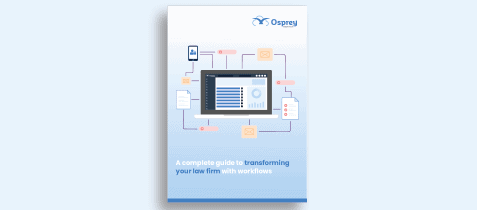Contents
How to reduce the cost and time of staying compliant
Meeting compliance requirements and regulations affects every part of your firm’s operations and, if not managed effectively, could cost you a lot both financially and in time and energy. According to Thomson Reuters’ Cost of Compliance 2021 report, the top compliance challenge law firms are expecting to face is the increasing volume of change. The amount of information expected to be published by regulators and exchanges was also expected to increase by 78% – the highest percentage since 2013.

To successfully manage continuous compliance changes it’s necessary to implement firm-wide solutions that improve and connect the team, culture, technology, and operational processes to future-proof your firm.
Technology sits at the heart of transformation and for law firms to remain competitive, deliver quality client service, increase cashflow and stay compliant, they need to take advantage of the digital tools that can streamline compliance processes. Adaptability and flexibility are key to navigating uncertainty and change, and that’s why a risk-aware, technology embracing culture will provide a strong foundation for successfully managing compliance.
Technology enables firms to implement automation, integrate compliance tasks, and evidence the proactive steps they’re taking to mitigate risk. It provides the digital tools that enable legal professionals to be proactive in reducing errors, follow best practices, and easily meet requirements.
Five ways to reduce the cost and time of staying compliant
Ben Kellett, Osprey’s Product Advisor & Workflow Developer, has listed his top five ways that firms can more effectively manage their compliance obligations. Having worked as both an IT Manager and a Practice Manager for high street firms over the last 15 years, Ben’s first-hand experience has taught him many lessons on how firms can improve performance and visibility.
You can view the webinar on-demand now.
1. Standardise tasks to allow automation
Every business knows that automation enables teams to do more with less. Automation removes the time-consuming and costly manual tasks, helping to improve the efficiency and productivity of a firm. This can provide endless benefits to a firm for managing compliance processes, but also across the wider business, including enhanced client service, employee satisfaction, and improved profitability.
Before firms can use technology to automate, they need to standardise processes and create agreed rules and collateral. Automation can only be effective when the entire team is following a standardised processes that incorporates the key branding, compliance, and client journey steps needed to deliver the service required.
Building out a series of practice area and process-specific workflows within your practice and case management solution (PCMS) is the best place to start. Osprey Approach provides over 50 pre-templated workflows that can be edited and configured to meet practices’ needs.
Pavilion Row, a York-based law firm specialising in wills and probate, use Osprey’s automated workflows to ensure compliance. Operations Director, Nicola Houston, explains, “Workflows ensure we’re being consistent. In all areas of the business, we use workflows for the key compliance tasks during the file opening process to ensure that we’re doing all the appropriate checks and we’re not missing anything.”
Workflows help to integrate compliance tasks into the daily workload of employees, so staying compliant becomes an easy habit to master. They provide greater control for managers and stakeholders because agreed upon processes are standardised across the firm so everyone, even junior lawyers, are following the same workflow. Workflows provide peace of mind to COLP, COFA, MLRO and other business stakeholders that nothing is missed, and best practices are always followed.
2. Streamline data collection to reduce errors
The data you collect, store, and use is at the core of all your compliance and regulation requirements and ensuring its accuracy, accessibility, and security needs to be a priority. This begins by streamlining your data collection process to guarantee that the data you put into your PCMS is valuable and reliable.
The best way streamline data collection and avoid human-error from rekeying data from paper files or client emails, is for your clients to input it directly into your case management system. This not only speeds up the process and reduces risks but provides a more convenient service to clients who can securely log on to their client portal and complete online questionnaires. Osprey enables you to create custom questionnaires that can be shared with clients, at any stage of a case, via the web portal so the responsibility of data capture lies with the client.
When completed online, data is collected and stored centrally in your case management solution to be used again in future letters or documents, without the need for copy and pasting. The same can be done with collecting other types of data such as signed documents, proof of identity, or bank statements. The collateral is collected once online and stored centrally for future reference.
3. Digitise client onboarding to improve due diligence
Provide an easy and convenient service to your clients and ensure compliance by digitalising your client onboarding using a secure, integrated web portal. There are a lot of moving parts and key compliance actions involved in onboarding a new client and so standardised processes that utilise a client portal is the best way to keep data and documents centralised and ensures tasks are completed on time.
Speed up your client due diligence formalities by reducing data duplication and utilising electronic signatures and digital verification checks. Osprey Approach integrates with leading e-signature tool, DocuSign, so you can get your client letters signed in hours, not days. Osprey also integrates with InfoTrack who offer a suite of digital client onboarding and verification checks to further streamline your onboarding processes.
4. Centralise billing processes to save time
Your accounting processes can be completed quicker, with the confidence of SRA compliance, when your accounting and time recording software is integrated into your PCMS. Integration provides the benefit of centralisation, which means all your financial, client, and matter data is stored once, improving accuracy and accessibility.
This also enables your time recording software to be fully integrated too, so all billable time is captured in real-time, meaning it can be submitted and billed quicker. Run an efficient accounts department with a solution that is compliant, connected, and provides visibility.
5. Gain visibility to increase control
When your data is connected and easily accessible, compliance officers are in control and can proactively monitor operations to resolve any potential breaches and non-compliance before they become an issue for the firm. Proactively reviewing processes reduces potential investigations, complaints, or claims and subsequently removes both the financial and reputation costs associated with those challenges. Similarly, access to real-time data helps you to prepare for audits, achieve accreditations, and meet regulations.
Powerful reporting tools help firms gain visibility so you’re always one step ahead. Firm-wide reporting provides management level insight that drives improvement, so you can perform at your best. It also provides the digital tools to evidence the steps your firm is taking to mitigate risk. Osprey Approach aids your COFA, COLP and MLOs with their compliance monitoring obligations. Key data sources and reports can be produced more easily which helps to alleviate the pressures of accreditation applications such as CQS, WIQS and Lexcel. Lengthy application processes can be reduced when your data and documents are organised and accessible.
Technology aids compliance
Compliance affects and involves every area of a law firm, and that’s the reason there is no single way to reduce the cost and time of staying compliant. It’s why staying compliant doesn’t just rely on improved operations, or a more focused team culture, or a new software solution; it involves adapting and improving processes and actions right across the firm. It’s those small improvements in efficiencies, productivity, and visibility that combine to have the biggest impact on reducing costs and mitigating risk.
A key takeaway is to avoid treating compliance regulations as an additional disconnected procedure. By embracing technology solutions to connect and integrate tasks, they can be easily implemented into your team’s daily workload, so they become a habit. When effective compliance habits are formed throughout a firm, stakeholders gain reassurance and confidence in the operational success of the business and fee earners are freed up from manual tasks to focus on value-added work that build client relationships.
Watch Ben’s presentation on reducing the cost of staying compliant, from our 2021 Autumn Roadshow, to discover the key features within Osprey Approach that saves time, reduces errors, and provides visibility.




